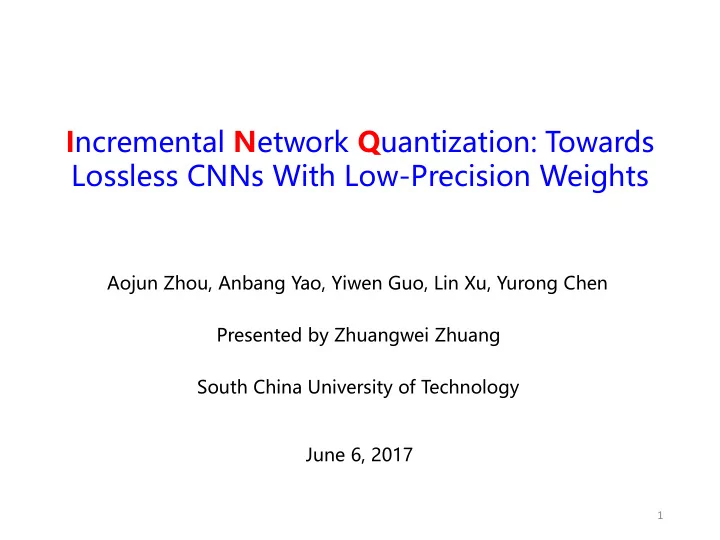

I ncremental N etwork Q uantization: Towards Lossless CNNs With Low-Precision Weights Aojun Zhou, Anbang Yao, Yiwen Guo, Lin Xu, Yurong Chen Presented by Zhuangwei Zhuang South China University of Technology June 6, 2017 1
Outline Background Motivation Proposed Methods Variable-length enconding Incremental quantization strategy Experimental Results Conclusions 2
Background 3
Background Huge networks lead to heavy consumption on memory and computational resources. ResNet-152 has model size of 230 MB , and needs about 11.3 billion FLOPs for a 224 × 224 image Difficult to implement deep CNNs on hardware with the limitation of computation and power. FPGA ARM 4
Motivation 5
Motivation Network quantization low-precision +1, 0, -1 Floating-point Fixed-point (full-precision) 2 𝑜 1 , … , 2 𝑜 2 , 0 CNN quantization still an open question due to two critical issues: Non-negligible accuracy loss for CNN quantization methods Increased number of training iterations for ensuring convergence 6
Proposed Methods 7
Proposed Methods 50% 75% 100% … Figure. Overview of INQ Pre-trained Weight Group-wise Retraining model partition quantization Figure. Quantization strategy of INQ 8
Variable-Length Encoding Suppose a pre-trained full precision CNN model can be represented by {W 𝑚 : 1 ≤ 𝑚 ≤ 𝑀} . 𝑚 : weight set of 𝑚 𝑢ℎ layer 𝑋 L: number of layers Goal of INQ: Convert 32 floating-point 𝑋 𝑚 to be low-precision W 𝑚 , each entry of W 𝑚 is chosen from 𝑚 = {±2 𝑜 1 , ⋯ , ±2 𝑜 2 , 0} , P where 𝑜 1 and 𝑜 2 are two integer numbers, and 𝑜 2 ≤ 𝑜 1 . 9
Variable-Length Encoding 𝑚 = {±2 𝑜 1 , ⋯ , ±2 𝑜 2 , 0} P 𝑚 is computed by: 𝑋 W 𝑚 𝑗, 𝑘 = ൝𝛾sgn 𝑋 𝑚 𝑗, 𝑘 if 𝛽 + 𝛾 ≤ 𝑏𝑐𝑡 W 𝑚 𝑗, 𝑘 < 3𝛾/2 0 otherwise, Where 𝛽 and 𝛾 are two adjacent elements in the sorted P 𝑚 , and 0 ≤ 𝛽 < 𝛾 . 10
Variable-Length Encoding 𝑚 = {±2 𝑜 1 , ⋯ , ±2 𝑜 2 , 0} P Define bit-width 𝑐 1 bit to represent 0, and the remaining bits to represent ±2 𝑜 𝑜 1 and 𝑜 2 are computed by 𝑜 1 = floor(log 2 (4𝑡/3)) 𝑜 2 = 𝑜 1 + 1 − 2 𝑐−1 /2 𝑡 is calculated by 𝑡 = max(abs(W 𝑚 )) 11
Incremental Quantization Strategy Figure. Result illustrations Quantization strategy: Weight partition: divide weights in each layers into two disjoint groups Group-wise quantization: quantize weights in first group Retraining: retrain whole network and update weights in second group 12
Incremental Quantization Strategy For the 𝑚 𝑢ℎ , weight partition can be defined as 1 ∪ A 𝑚 2 = W 𝑚 𝑗, 𝑘 1 ∩ A 𝑚 2 = ∅ A 𝑚 , and A 𝑚 1 : first weight group that needs to be quantized A 𝑚 2 : second weight group that needs to be retrained A 𝑚 Define binary matrix T 𝑚 (1) T 𝑚 𝑗, 𝑘 = ቐ0, W 𝑚 (𝑗, 𝑘) ∈ A 𝑚 (2) 1, W 𝑚 (𝑗, 𝑘) ∈ A 𝑚 Update W 𝑚 𝜖𝐹 W 𝑚 𝑗, 𝑘 ← W 𝑚 𝑗, 𝑘 − γ T 𝑚 (𝑗, 𝑘) 𝜖 W 𝑚 𝑗, 𝑘 13
Incremental Quantization Strategy Algorithm. Pseudo Code of INQ 14
Experimental Results 15
Results on ImageNet Table. Converting full-precision models to 5-bit versions 16
Analysis of Weight Partition Strategies Random partition: all weights have equal probability to fall into the two groups Pruning-inspired partition: weights with larger absolute values have more probability to be quantized Table. Comparison of different weight partition strategies on ResNet-18 17
Trade-Off Between Bit-Width and Accuracy Table. Exploration on bit-width on ResNet-18 Table. Comparison of the proposed ternary model and the baselines on ResNet-18 18
Low-Bit Deep Compression Table. Comparison of INQ+DNS, and deep compression method on AlexNet. Conv: Convolutional layer, FC: Fully connected layer, P: Pruning, Q: Quantization, H: Huffman coding 19
Conclusions 20
Conclusions Contributions Present INQ to convert any pre-trained full-precision CNN model into a lossless low-precision version The quantized models with 5/4/3/2 bits achieve comparable accuracy against their full-precision baselines Future work Extend incremental idea from low-precision weights to low- precision activations and low-precision gradients . Implement the proposed low-precision models on hardware platforms 21
Q & A 22
References [1] Aojun Zhou, Anbang Yao, Yiwen Guo, Lin Xu, and Yurong Chen. Incremental network quantization: Towards lossless cnns with low-precision weights. In ICLR , 2017. [2] Yiwen Guo, Anbang Yao, and Yurong Chen. Dynamic network surgery for efficient dnns. In NIPS , 2016. [3] Song Han, Jeff Pool, John Tran, and William J. Dally. Learning both weights and connections for efficient neural networks. In NIPS , 2015. [4] Song Han, Jeff Pool, John Tran, and William J. Dally. Deep compression: Compressing deep neural networks with pruning, trained quantization and Huffman coding. In ICLR , 2016. [5] Fengfu Li and Bin Liu. Ternary weight networks. arXiv preprint arXiv: 1605.04711v1 , 2016 [6] Mohammad Rastegari, Vicente Ordonez, Joseph Redmon, and Ali Farhadi. Xnor-net: Imagenet classification using binary convolutional neural networks. arXiv preprint arXiv: 1603.05279v4 , 2016. 23
Recommend
More recommend